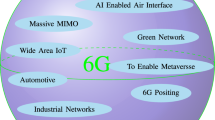Abstract
A dual-polarized multiple-input multipleoutput (MIMO)antenna is proposed for 5G base stations. Each antenna element consists of two orthogonally placed fan-shaped dipole elements and ±45° dual-polarized feeding structures are used to achieve broadband operation. The resonant frequency of the array element is from 3.3 to 4.2 GHz, which covers the mainstream spectrum allocations of 5G mobile networks. H-shaped coupling elements are used to improve the isolation between the neighboring antenna elements and the mutual coupling is reduced by over 4 dB. The envelope correlation of a 2 × 2 array is provided for verification.
Similar content being viewed by others
References
M. R. Palattella, M. Dohler, A. Grieco, et al. Internet of things in the 5G era: enablers, architecture, and business models [J]. IEEE Journal on Selected Areas in Communications, 2016, 34(3): 510–527.
K. E. Skouby, P. Lynggaard. Smart home and smart city solutions enabled by 5G, IoT, AAI and CoT services [C]//International Conference on Contemporary Computing and Informatics, Mysore, 2014: 874–878.
M. Chen, Y. Zhang, Y. Li, et al. EMC: Emotion-aware mobile cloud computing in 5G [J]. IEEE Network, 2015, 29(2): 32–38.
Q. Han, S. Liang, H. Zhang. Mobile cloud sensing, big data, and 5G networks make an intelligent and smart world [J]. IEEE Network, 2015, 29(2): 40–45.
Ministry of industry and information technology of the China. [EB/OL]. http://www.miit.gov.cn/n1146290/n4388791/c5906943/content. html.
R. W. Dearnley, R. J. Brandau, G. Xu. High isolation dual polarized antenna system using dipole radiating elements: U.S. Patent 5,952,983 [P]. 1999-9-14.
Q. X. Chu, D. L. Wen, Y. Luo. A broadband ±45° dual-polarized antenna with Y-shaped feeding lines [J]. IEEE Transactions on Antennas and Propagation, 2015, 63(2): 483–490.
Y. H. Cui, R. L. Li, H. Z. Fu. A broadband dual-polarized planar antenna for 2G/3G/LTE base stations [J]. IEEE Transactions on Antennas & Propagation, 2014, 62(9): 4836–4840.
D. Z. Zheng, Q. X. Chu. A multimode wideband ±45° dual-polarized antenna with embedded loops [J]. IEEE Antennas & Wireless Propagation Letters, 2017, 16: 633–636.
Y. Cui, X. N. Gao, H. Fu, et al. Broadband dual-polarized dual-dipole planar antennas for base station applications: analysis, design, and application for base stations [J]. IEEE Antennas & Propagation Magazine, 2017, 59(6): 77–87.
Q. Wu, S. Guo, X. Chen. Design of a low-profile MIMO antenna for 698-2700 MHz LTE femtocell base stations [J]. IEEE Antennas & Propagation Magazine, accepted.
X. Chen, S. Guo, Q. Wu. Link-level analysis of a multiservice indoor distributed antenna system [wireless corner] [J]. IEEE Antennas & Propagation Magazine, 2017, 59(3): 154–162.
A. C. K. Mak, C. R. Rowell, R. D. Murch. Isolation enhancement between two closely packed antennas [J]. IEEE Transactions on Antennas & Propagation, 2008, 56(11): 3411–3419.
J. B. Yan, J. T. Bernhard. Design of a MIMO dielectric resonator antenna for LTE femtocell base stations [J]. IEEE Transactions on Antennas & Propagation, 2012, 60(2): 438–444.
Author information
Authors and Affiliations
Corresponding author
Additional information
Qi Wu [corresponding author] was born in China. He received the B.S. degree from East China Normal University, Shanghai, China, and the Ph.D. Degree from Shanghai Jiao Tong University, Shanghai, China, both in Electrical Engineering, in 2004 and 2009, respectively. He joined the faculty of School of Electronics and Information Engineering, Beihang University (BUAA), Beijing, China, in 2009. Now he is an associate professor. During 2011 and 2012, he was a visiting scholar in the Department of Electrical Engineering, University of California, Los Angeles. Since 2014, he is an Alexander von Humboldt Fellow in the Institute of Electromagnetic Theory, Technical University of Hamburg-Harburg, Germany. He has authored over 20 journal papers, one book in Chinese “Planar monopole and dipole antennas: theory and ultrawideband applications”. He holds four Chinese patents as the first inventor. His research interests include broadband antennas, computational electromagnetics, and related EMC topics.
Dr. Wu received the Distinguished Young Faculty Award from BUAA in 2010, the Young Scientist Award from the International Union of Radio Science (URSI) in 2011, the Nominee Award for Excellent Doctoral Dissertation from the National Minister of Education in 2012, a Natural Science Award from Shanghai Government in 2013, and the Excellent Supervisor for Master Thesis from BUAA twice. (Email: qwu@buaa.edu.cn)
Peiyu Liang was born in China. He received the B.S. degree from the School of Electronics and Information Engineering, Beihang University (BUAA), Beijing, China, in 2015. He is now a master student in BUAA. From 2016 to 2017, he was an academic guest in the Institute of Electromagnetic Theory, Technical University of Hamburg-Harburg, Germany. His research interests include characteristic mode analysis of mutual coupling between antennas and wireless power transfer. (Email: godzilla1020@163.com)
Xiaoming Chen was born in China. He received the B.S. degree in electrical engineering from Northwestern Polytechnical University, Xi’an, China, in 2006, and the M.S. and Ph.D. degrees in electrical engineering from the Chalmers University of Technology, Gothenburg, Sweden, in 2007 and 2012, respectively. From 2013 to 2014, he was a post-doctoral researcher in the Chalmers University of Technology. From 2014 to 2017, he was an antenna specialist in Qamcom Research and Technology AB, Gothenburg, Sweden. Since 2017, he has been a Professor in Xi’an Jiaotong University, Xi’an. His current research interests include MIMO antennas, over-the-air testing, reverberation chambers, and hardware impairments and mitigation. Prof. Chen was the recipient of the Young Scientist Award from URSI 2017. He serves as an associate editor for IEEE Antennas andWireless Propagation Letters and is a reviewer for several IEEE journals. (Email: xiaoming.chen@mail.xjtu.edu.cn)
Rights and permissions
About this article
Cite this article
Wu, Q., Liang, P. & Chen, X. A Broadband ±45° Dual-Polarized Multiple-Input Multiple-Output Antenna for 5G Base Stations with Extra Decoupling Elements. J. Commun. Inf. Netw. 3, 31–37 (2018). https://doi.org/10.1007/s41650-018-0002-9
Received:
Accepted:
Published:
Issue Date:
DOI: https://doi.org/10.1007/s41650-018-0002-9




